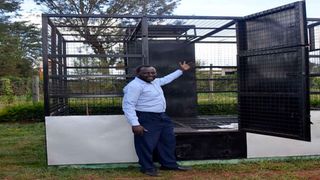
Dr Isaiah Muchilwa with his dryer at Maridadi Farm in Kitale. Below: The maize dryer with maize inside.
| Gerald Bwisa | Nation Media GroupSeeds of Gold
Premium
Dry your maize the modern way
Many maize farmers have harvested their produce, but one of the sad realities they have to grapple with is that 30 per cent of the grains would go to waste due to poor handling and drying and lack of good storage facilities.
Well, this has been the trend for years as post-harvest losses mount. However, this will soon be a thing of the past, according to Dr Isaiah Etemo Muchilwa, a lecturer at the department of mechanical, production and energy engineering at Moi University, who has come up with a solar dryer that promises to save farmers from losses.
Dubbed a Cobbed maize dryer, the lecturer, 46, notes that he was inspired to make it after seeing the problems farmers go through.
“I lived in Trans Nzoia where I saw people growing maize and post-harvest losses were a big challenge,” says Dr Muchilwa, who in 2011 got a scholarship to study for his PhD in Germany.
It is while undertaking his studies that he came up with the project funded through a research grant from the German Federal Ministry for Education and Research under the First German-African Innovation Incentive Award, with additional support from Volkswagen Foundation.
Waste blankets
He came up with the innovation in partnership with Prof Oliver Hensel, who heads the Department of Agricultural Engineering at the University of Kassel in Germany.
The maize dryer is a metallic, rectangular gadget fitted with a transparent rooftop, has wire mesh on the sides and inside, waste blankets and sisal gunny bags are used to provide warm conditions.
The technology is designed to enable farmers harvest their produce early and dry it well as faster as possible.
“The dryers we make target small and medium-size farmers. They can host 10 to 1,000 bags. The covering material is light and transparent to trap heat. Inside, we have cotton/waste blankets, sisal gunny bags for insulation and to allow moisture to escape while conserving the heat,” explains Dr Muchilwa.
The dryer, which relies on fans that are powered by solar power or electricity and biomass/firewood in case of the absence of the two, drives air within the structure to speed up the drying process.
Minimise losses
“The cobbed maize that is loaded into the dryer should first be sorted to ensure none is rotten, mouldy or germinated. It is important to harvest on time to minimise losses from extreme weather, theft and damage from rodents and weevils. The dryer can take up cobbed maize with moisture content of as high as 35 per cent,” says Dr Muchilwa, adding this makes the machine different from others that only take shelled maize.
According to him, cobbed maize is easier to dry because of the spaces that give room for easy flow of air.
“Inside the dryer, there is a thermo-hygrometer that measures temperature and relative humidity of the air surrounding the cobbed maize. The gadget is linked to an android app, making it easy to monitor the goings-on in the dryer using a phone from as far as 50 metres away.”
Maize should be dried to have a moisture content of 13.5 percent, says Dr Muchilwa, who has further developed a moisture meter dubbed mootle (moisture metering bottle) for use alongside the dryer.
Apart from maize, the dryer can also be used, with slight adjustments, to dry assorted fruits, vegetables, roots and tubers, herbs and spices. It can also be applied to dry timber for construction, adds the lecturer.
It is environmentally friendly and climate-smart, says Dr Muchilwa, since it uses solar energy and in the absence of solar, it uses crop residues to generate heat and energy, making it cheaper and efficient to operate.
Sh100,000
“The 10-20 tonnes capacity dryer costs Sh450,000. However, we are working on those that can cost Sh100,000 to be used by small farmers who can buy them in groups.”
The current model is fixed, but Dr Muchilwa says it can be made portable by mounting it on wheels for easy deployment from one farm to another.
Benjamin Wanyama, who runs Mbai Farm in Kitale, says he has managed to address post-harvest losses by drying his produce faster using the machine.
“The good thing with the machine is that we will be able to fabricate for farmers any size they want,” says Dr Muchilwa.
Robert Musikoyo, the agriculture chief officer in Trans Nzoia, said the quality of maize grain produced in the county has been declining due to erratic weather, especially when it rains excessively during harvesting season.
“Aflatoxin contamination has been rampant due to poor drying but with the innovation, we will be able to supplement our four mobile dryers that are available to assist farmers dry maize after harvesting. From the 107,000 hectares under maize, we expect to harvest 4.8 million bags.”





